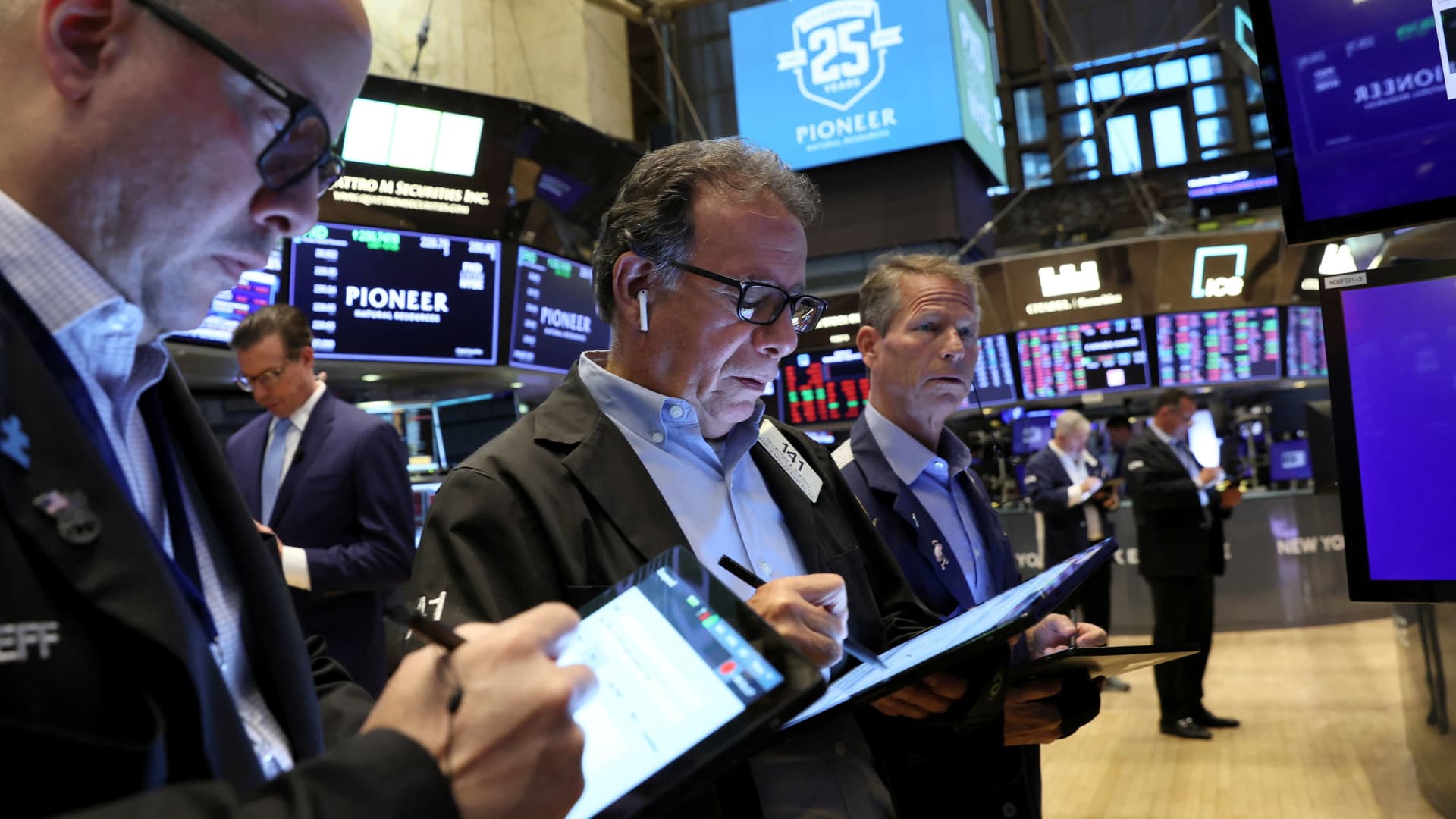October has a reputation for spooking investors with its wild swings. But it has also often been the time when markets form bottoms before riding higher into what can be the best time of year for stocks. In the week ahead, the market could show more evidence of whether a bottom is forming, as investors wade through a flood of earnings reports from a diverse group of S & P 500 companies. Goldman Sachs , Procter & Gamble , Bank of America , Tesla, Netflix , United Airlines and Johnson and Johnson are among the nearly five dozen S & P 500 names reporting. As for the market, it stuck to its October playbook for wild moves in the past week. In an especially volatile session, stocks plunged to a new low Thursday after a hot consumer inflation report and then spring boarded sharply higher. That action has encouraged some strategists to believe the market has formed or is about to form at least a near-term bottom, even as stocks traded lower Friday. “We think that there is a very strong likelihood that you are making a bottom, setting the stage for a bear market rally during the time of year – October – when you typically see these types of events,” said Julian Emanuel, head of equity, derivatives and quantitative research at Evercore ISI. “We’re heading into a stretch that historically, post-midterms and into the following year, tend to be very positive for stocks.” Emanuel said the market could also be buoyed by the fact that sentiment is very negative and “justifiably so.” “You’re at the lows and the Fed keeps hiking,” he said. But he sees the chance for a 17% to 20% rally in the S & P 500. “When we think about an August peak, a September plunge, and the well-worn tradition of October bottoms leading to fourth quarter rallies, given the sentiment and positioning backdrop, we think the odds are good for this rally coming to fruition,” Emanuel said. Historically, in mid-term election years, the market bottoms Oct. 9 , clearing the way for a fourth quarter gain, according to Oppenheimer. “The fact that October has delivered its usual hazards and wild swings is encouraging” according to Stock Trader’s Almanac. The Almanac’s website notes the seasonal patterns and four-year cycle patterns are following historic trends. “This would culminate in a bear market low sometime near the end of October,” it noted. Stock Trader’s Almanac points out that more bear markets have ended in October than any other month. Also, in the six months starting in November, stocks have been higher in all 18 mid-term years since 1950. But Emanuel said it is unclear how long the rally will last. “There are so many political and geopolitical events through the end of the year, it’s very difficult to say how long it’s going to last,” he said. Technically speaking For some analysts who watch charts, Thursday’s big “outside up day” in the stock market was bullish and set the stock market up for a seasonal surge higher. Katie Stockton, founder of Fairlead Strategies, said after the S & P 500 hit a low 3,491.58 Thursday, she now sees initial resistance on the upside at 3,914. The S & P 500 was down about 0.9% for the week, as of Friday afternoon, and it was hovering just above 3,600. “That’s a level that has acted as both support and resistance in the past,” she said. “To us, that’s a reasonable objective. I wouldn’t be surprised to see it cleared, but it’s a first resistance.” Stockton said some of her indicators show positive momentum for the market, and it is the seasonally positive time of year. While she expects a significant rally, she does not have indications about whether it will last through year end. “The implications are short-term, but they have the potential to be more intermediate-term, meaning weeks, not days, and we have some positive seasonal factors coming into play,” she said. Risks remain Emanuel says higher interest rates could continue to be a problem for stocks and are a risk for the rally. The U.S. 10-year yield was at 4.02% Friday, near the top of its recent range. While investors seem less anxious about the U.K., National Alliance’s Andy Brenner said markets aren’t out of the woods. British sovereign debt yields surged after the U.K. government announced plans to cut taxes and increase spending. The Bank of England stepped in to buy bonds, temporarily soothing the markets, and helping U.K. pension funds that were hurt by the sudden surge in yields. Yields move opposite price. “Today was the last day of the Bank of England intervening, and now the Bank of England in two weeks is going to start selling bonds,” said Brenner. “I think the bond vigilantes are drooling over the next two weeks.” He said the U.K. 30-year gilt saw a near 60 basis point move higher in yield Friday, even as the U.K. government reversed the tax plan and named a new finance minister. Earnings season Another risk for the market is earnings. Third quarter earnings started in the past week with better-than-expected reports from major banks JP Morgan , Wells Fargo and Citigroup . Comments from managements of companies reporting in the week ahead will be watched for insight on supply chain issues, cost inflation and pricing power. “Analysts are trying to get more color so they can know what to do with forward estimates,” said Liz Ann Sonders, Charles Schwab chief market strategist. “Also the currency impact – rough estimates are that every 1% move in the dollar hits earnings by a half percent…Even in the second quarter, you had big multinational companies starting to talk about the impact of the strong dollar. ” S & P 500 earnings are expected to grow by 3.6% for the third quarter, based on actual reports and estimates, according to Refinitiv. Without the boost from more than doubling profits from energy companies, S & P earnings would decline by 3.1%. Sonders said the market needs to see more stability in forward earnings before it can move get past the current choppy period. She said investors also have to come to grips with the fact the Federal Reserve is not planning to pivot to rate cuts, after it completes its rate hiking cycle next year. “A lot of the sentiment and technical and even breadth indicators are starting to line up in a way that makes the outlook relatively good if your horizon is a year out,” said Liz Ann Sonders, chief market strategist at Charles Schwab. Week ahead calendar Monday Earnings: Bank of America , Bank of NY Mellon, Charles Schwab 8:30 a.m. Empire State manufacturing Tuesday Earnings: Netflix, Johnson and Johnson, Goldman Sachs, United Airlines , J.B. Hunt Transport, Interactive Brokers , Truist Financial, Albertsons , State Street, Hasbro, SunTrust, FNB, Intuitive Surgical 8:30 a.m. Business leaders survey 9:15 a.m. Industrial production 10:00 a.m. NAHB survey 4:00 p.m. TIC data 5:30 p.m. Minneapolis Fed President Neel Kashkari Wednesday Earnings: Procter & Gamble , Tesla, IBM , Travelers, Knight-Swift Transportation, Lam Research, Alcoa , PPG Industries , Nasdaq, Abbott Laboratories, Citizens Financial, Baker Hughes, Elevance Health, Winnebago, Northern Trust , Steel Dynamics, Equifax, WD-40, Comerica, Prologis, Ally Financial 8:30 a.m. Housing starts 1:00 p.m. Minneapolis Fed’s Kashkari 2:00 p.m. Beige book 6:30 p.m. Chicago Fed President Charles Evans 6:30 p.m. St. Louis Fed President James Bullard Thursday Earnings: AT & T, Dow, American Airlines , CSX, Whirlpool , Snap, Blackstone, Union Pacific, Nokia, LM Ericsson, Danaher , ManpowerGroup, Boston Bear , Tenet Healthcare, Freeport-McMoRan, Fifth Third, KeyCorp, Quest Diagnostics , Marsh and McLennan, Philip Morris , Genuine Parts, Tractor Supply, Pool Corp 8:30 a.m. Initial claims 8:30 a.m. Philadelphia Fed manufacturing 10:00 a.m. Existing home sales Friday Earnings: American Express , Verizon, Regions Financial, Schlumberger , Interpublic, Huntington Bancshares, HCA Healthcare
October’s wild trading could give way to a new stock rally, as earnings roll out in week ahead
Related Posts
RECENT POSTS
Browse by Category
- Books (1)
- Business (3,362)
- Events (2)
- Fashion (5,281)
- Horror (1)
- Interviews (28)
- Movies (5,277)
- Music (5,311)
- News & Gossip (6,136)
- Television (5,307)
- Uncategorized (1)
- Video Of The Day (855)
POPULAR POSTS
EDITOR'S PICKS
© 2022 EssentiallyHollywood.com - All Rights Reserved
















































































